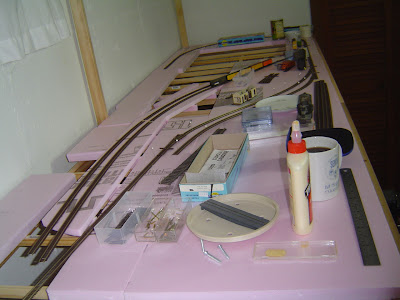
Today the chief engineer was scheduled to oversee some tracklaying, but something else caught his eye: an observation car at a bargain price! Just the kind of rolling stock the chief had in mind for his personal business car.
Almost none of the passenger cars on the LoCo have interiors because they're nearly all bargain-shelf Athearn models -- not that there's anything wrong with them. On the contrary, at the prices commanded by commercially-available finished models, there wouldn't be but a tiny handful of rolling stock on the roster if it weren't for the bare-bones models from Athearn, which the management of the Lost Continent Railway finds perfectly presentable.
The body shop at Dog Water Flowage is still under repair after its nearly total destruction in a conflagration triggered by a short in the heating element of an unauthorized distillery hidden under the floorboards, so the chief engineer began to assemble the car on his own, normally a very quick and easy task of screwing the wheel trucks to the floor, then the weights. Windows snap into the openings and a few extra bits of detail like the brake wheel and the railing around the observation platform would finish the car in just a few minutes.
But the head end of the car has no bulkhead for the vestibule, so the chief cut one from a piece of .020 polystyrene using the rear bulkhead as a pattern, carefully tracing the windows for a doorway and cementing it to the sides with some scrap styrene strip.
"That was pretty easy," the chief thought, wondering how long it would take to add a couple rooms and a side passage. The trick, he realized after eyeballing the job, was that the sides and roof of Athearn cars are cast as a shell that clips over the floor. It would be much easier if the roof came off. How difficult could that be?
Only one way to find out.

































